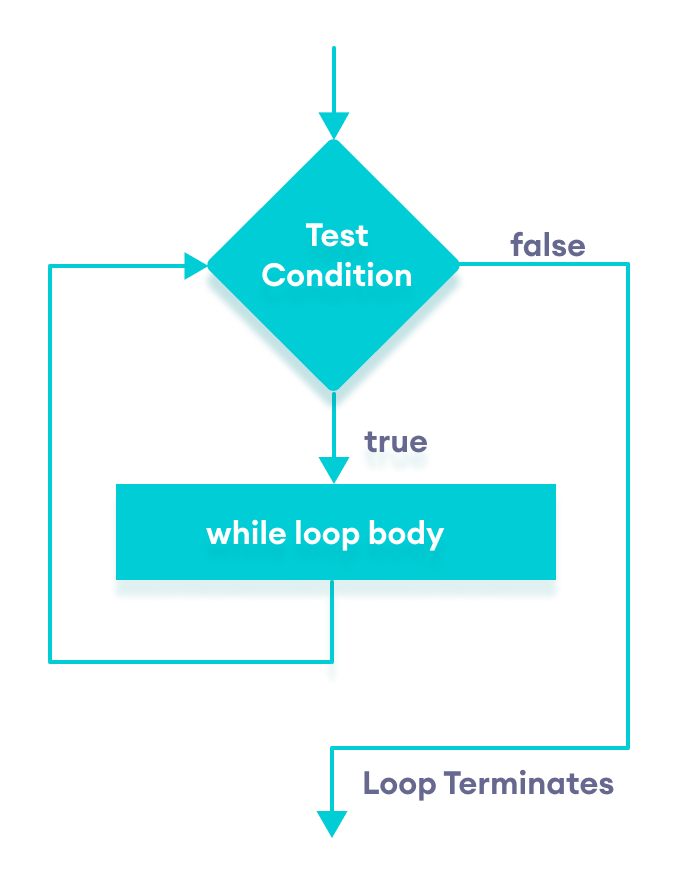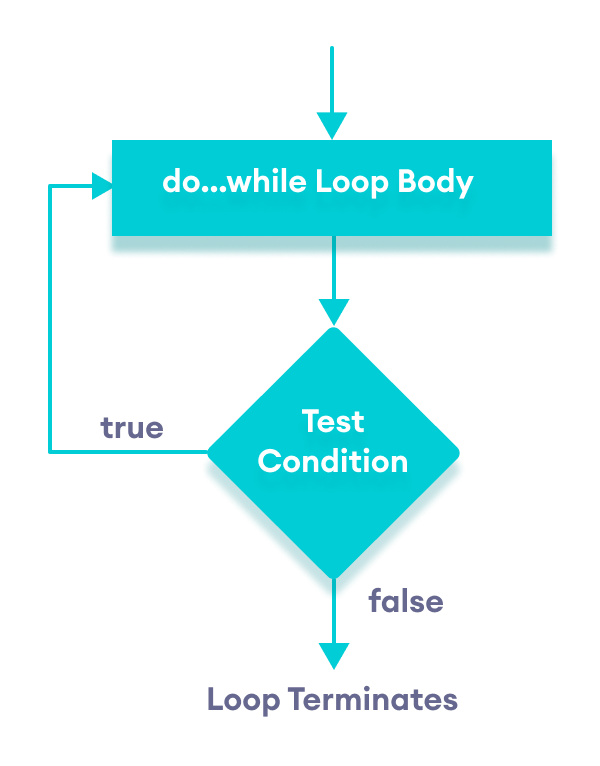In computer programming, loops are used to repeat a block of code.
For example, let's say we want to show a message 100 times. Then instead of writing the print statement 100 times, we can use a loop.
That was just a simple example; we can achieve much more efficiency and sophistication in our programs by making effective use of loops.
There are 3 types of loops in C++.
forloopwhileloopdo...whileloop
while Loop
The syntax of the while loop is:
while (condition) {
// body of the loop
}Here,
- A
whileloop evaluates thecondition - If the
conditionevaluates totrue, the code inside thewhileloop is executed. - The
conditionis evaluated again. - This process continues until the
conditionisfalse. - When the
conditionevaluates tofalse, the loop terminates.
Flowchart of while Loop
Example 1: Display Numbers from 1 to 5
// C++ Program to print numbers from 1 to 5
#include <iostream>
using namespace std;
int main() {
int i = 1;
// while loop from 1 to 5
while (i <= 5) {
cout << i << " ";
++i;
}
return 0;
}Output
1 2 3 4 5
Here is how the program works.
| Iteration | Variable | i <= 5 | Action |
|---|---|---|---|
| 1st | i = 1 | true | 1 is printed and i is increased to 2. |
| 2nd | i = 2 | true | 2 is printed and i is increased to 3. |
| 3rd | i = 3 | true | 3 is printed and i is increased to 4 |
| 4th | i = 4 | true | 4 is printed and i is increased to 5. |
| 5th | i = 5 | true | 5 is printed and i is increased to 6. |
| 6th | i = 6 | false | The loop is terminated |
Example 2: Sum of Positive Numbers Only
// program to find the sum of positive numbers
// if the user enters a negative number, the loop ends
// the negative number entered is not added to the sum
#include <iostream>
using namespace std;
int main() {
int number;
int sum = 0;
// take input from the user
cout << "Enter a number: ";
cin >> number;
while (number >= 0) {
// add all positive numbers
sum += number;
// take input again if the number is positive
cout << "Enter a number: ";
cin >> number;
}
// display the sum
cout << "\nThe sum is " << sum << endl;
return 0;
}Output
Enter a number: 6 Enter a number: 12 Enter a number: 7 Enter a number: 0 Enter a number: -2 The sum is 25
In this program, the user is prompted to enter a number, which is stored in the variable number.
In order to store the sum of the numbers, we declare a variable sum and initialize it to the value of 0.
The while loop continues until the user enters a negative number. During each iteration, the number entered by the user is added to the sum variable.
When the user enters a negative number, the loop terminates. Finally, the total sum is displayed.
do...while Loop
The do...while loop is a variant of the while loop with one important difference: the body of do...while loop is executed once before the condition is checked.
Its syntax is:
do {
// body of loop;
}
while (condition);Here,
- The body of the loop is executed at first. Then the
conditionis evaluated. - If the
conditionevaluates totrue, the body of the loop inside thedostatement is executed again. - The
conditionis evaluated once again. - If the
conditionevaluates totrue, the body of the loop inside thedostatement is executed again. - This process continues until the
conditionevaluates tofalse. Then the loop stops.
Flowchart of do...while Loop
Example 3: Display Numbers from 1 to 5
// C++ Program to print numbers from 1 to 5
#include <iostream>
using namespace std;
int main() {
int i = 1;
// do...while loop from 1 to 5
do {
cout << i << " ";
++i;
}
while (i <= 5);
return 0;
}Output
1 2 3 4 5
Here is how the program works.
| Iteration | Variable | i <= 5 | Action |
|---|---|---|---|
i = 1 | not checked | 1 is printed and i is increased to 2 | |
| 1st | i = 2 | true | 2 is printed and i is increased to 3 |
| 2nd | i = 3 | true | 3 is printed and i is increased to 4 |
| 3rd | i = 4 | true | 4 is printed and i is increased to 5 |
| 4th | i = 5 | true | 5 is printed and i is increased to 6 |
| 5th | i = 6 | false | The loop is terminated |
Example 4: Sum of Positive Numbers Only
// program to find the sum of positive numbers
// If the user enters a negative number, the loop ends
// the negative number entered is not added to the sum
#include <iostream>
using namespace std;
int main() {
int number = 0;
int sum = 0;
do {
sum += number;
// take input from the user
cout << "Enter a number: ";
cin >> number;
}
while (number >= 0);
// display the sum
cout << "\nThe sum is " << sum << endl;
return 0;
}Output 1
Enter a number: 6 Enter a number: 12 Enter a number: 7 Enter a number: 0 Enter a number: -2 The sum is 25
Here, the do...while loop continues until the user enters a negative number. When the number is negative, the loop terminates; the negative number is not added to the sum variable.
Output 2
Enter a number: -6 The sum is 0.
The body of the do...while loop runs only once if the user enters a negative number.
Infinite while loop
If the condition of a loop is always true, the loop runs for infinite times (until the memory is full). For example,
// infinite while loop
while(true) {
// body of the loop
}Here is an example of an infinite do...while loop.
// infinite do...while loop
int count = 1;
do {
// body of loop
}
while(count == 1);In the above programs, the condition is always true. Hence, the loop body will run for infinite times.
for vs while loops
A for loop is usually used when the number of iterations is known. For example,
// This loop is iterated 5 times
for (int i = 1; i <=5; ++i) {
// body of the loop
}Here, we know that the for-loop will be executed 5 times.
However, while and do...while loops are usually used when the number of iterations is unknown. For example,
while (condition) {
// body of the loop
}






No comments:
Post a Comment